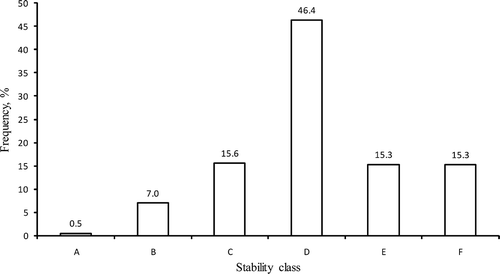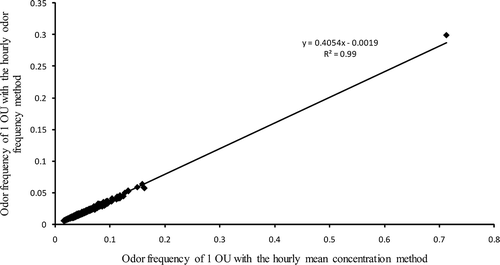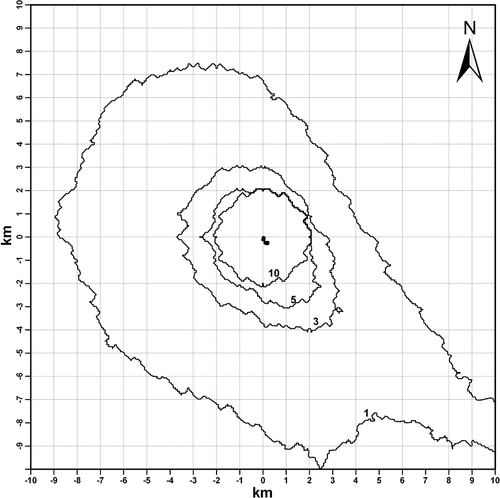ABSTRACT
Setback distance has been used as an effective tool to avoid odor nuisance from livestock operations. Many setback distances were guidelines that were determined by empirical methods that are considered to be lack of science base. Air dispersion models have been used to determine setback distances; however, these models do not consider the short-time fluctuations of odor. A livestock odor dispersion model (LODM) was developed to consider the short-time variations of odor and predict occurrence frequency for certain levels of odor. In this study, this model was used to predict the occurrence frequency for various levels of odor in the vicinity (10 km) of a swine farm. Using selected odor criteria, setback distances between the swine farm and nearby communities were defined. Results indicate that the LODM can be used as an effective tool to determine setback distances.
One of the more important applications of odor dispersion models is to determine setback distances for major odor sources, such as intensive livestock operations, from nearby communities. This study provided a case study in determining directional setback distances from a typical swine farm using a newly developed livestock odor dispersion model (LODM). It is also the first study in using hourly odor frequency to determine setback distances.
INTRODUCTION
Community concern and complaints about emissions of air pollutants, especially odor, from livestock operations have become important obstacles for the development of livestock industry.Citation1 Building a new livestock operation, expanding, or intensifying an existing livestock operation must address public concern of livestock odor. One widely used approach to deal with odor concern is to establish appropriate setback distances to separate the livestock production facilities from residences or public facilities. If the setback distances are too large, development and expansion of the animal industry will be restricted; however, insufficient separation distances will result in odor complaints and possibly lawsuits against the animal producers.Citation2 Most of the existing setback distances are determined by simple parameterizations of the odor source (animal number and weight), dilution of the emission (emission factor), or assessment of the protection level (land use category).Citation3 This approach does not account for variable odor emissions and complex odor dispersion, which may be a result of variations in local weather conditions and topography.
Odor emissions from animal production facilities are a function of many variables in addition to animal number and weight including housing types, feeding methods, manure storage and handling methods, and weather conditions. The impact of odors on surrounding neighbors and communities depends on the odor emission rates, local meteorological conditions, topography, and odor sensitivity and tolerance of the neighbors.2 Odor dispersion models were designed to simulate the complex odor dispersion after emission from the sources. The capability of a model to account for variable emission rates, multiple sources, weather conditions, and topography makes the odor dispersion model an effective tool to estimate appropriate setback distances.
Odor dispersion models can be used as a tool to simulate the odor concentrations and the odor frequencies around animal facilities. Acceptable odor criterion should be used to obtain acceptable separate distance. By far, the most widely used odor criterion is the occurrence frequency of odor with concentrations exceeding a defined threshold. Although the criteria used by various jurisdictions are different, both in terms of odor concentration and occurrence frequency, odor concentrations are usually in the range of 1–10 olfactory units (OU) with 1 OU being most commonly used. Occurrence frequencies usually vary from 0.01% to 10%.Citation4
A few setback distance models have been developed from odor dispersion models, including the OFFSET model and the Nebraska odor footprint model. The OFFSET modelCitation5 Citation6 was developed based on simulations using INPUFF2 (a Gaussian puff dispersion model) under steady-state weather conditions to define relationships between odor emissions from livestock operations and setback distances for different annoyance-free times. It selected 75 OU (faint odor by intensity) as the acceptable odor concentration to calculate setback distances. Six different steady-state weather conditions with neutral to stable atmospheric conditions were chosen to calculate the setback distances required to reduce the odor concentration to 75 OU. The occurrence of each weather condition was considered as the odor occurrence frequency. Various setback distances were generated to meet different annoyance-free odor requirements of the surrounding neighbors. The Nebraska odor footprint modelCitation7 was based on AERMOD (a steady-state Gaussian plume model). It generates directional setback distances using methods similar to that of OFFSET. The acceptable odor concentration selected by this model is also 75 OU. However, in this model the annual historic hourly metrological data were used as the model input. Therefore, unlike the OFFSET model, the actual odor occurrence frequencies of 75 OU were estimated. As pointed out in a study of Yu et al.,1 the odor criteria used to achieve the same setback distance should be different when using steady-state weather conditions as was used in the OFFSET model and the annual hourly weather data as used in the Nebraska odor footprint model. The odor concentration that was used as odor criterion should be much lower when using annual hourly weather data. Therefore, the odor criteria used in Nebraska model might be too high.
One of the important characteristics of odor that differs from other air pollutants is its instantaneous nature. Due to variable weather conditions and the turbulent motion of the atmosphere, random odor concentration fluctuations may exist. Short-term (a few seconds) odors that exceed the odor detection threshold can cause odor nuisance, even if the long time (hourly) average concentration is well below the detection threshold.Citation8 The Austrian odor dispersion model (AODM) that has been used to calculate the setback distances used peak to mean ratios to account for this time-scale problem.Citation9 A better approach might be using a model that can consider the odor concentration fluctuations to estimate the odor frequency of certain level odor. The livestock odor dispersion model (LODM)Citation10 Citation11 has the ability to consider the short time odor concentration fluctuations with the input of hourly meteorological data. The objective of this study was to determine directional setback distances of a selected swine farm using LODM and various odor criteria.
MATERIALS AND METHODS
The Swine Farm
A typical swine finishing farm located in Saskatchewan, Canada, was selected as the odor source for this study. This farm had one barn with 10 rooms for 11,550 feeder pigs and an uncovered, two-cell earthen manure storage (EMS) basin. The barn was mechanically ventilated with wall-mounted fans. There were shallow manure pits underneath the fully slatted floor that were gravity-drained once every 2 to 4 weeks. Odor emission rates measured by Guo et al.Citation12 from May to October 2003 were used in this study (). The farm was located in a rural, arable field with flat terrain and no obstacles.
Table 1. Odor emission rates of selected swine farm
Meteorological Data
The meteorological data used in this study for determining setback distances were 10 years (1993 to 2002) of historically collected hourly weather data. The meteorological parameters involved were wind speed, wind direction, temperature, stability class, and mixing height.
LODM and Its Prediction of Odor Concentration and Odor Frequency
LODM was designed specifically for odor dispersion from livestock facilities. It is capable of considering short time odor concentration fluctuations and is able to estimate the hourly odor frequency from hourly input meteorological data. It can also deal with multiple sources and variable emission rates. The model theory and methods, as well as a validation with field plume measurement data, have been published.Citation10 Citation11 The simulation period for this study was the warm season from May 1 to October 31. The warm season was also called the odor season because it was the period that people experienced greater exposure to odor due to frequent outdoor activities and increased odor emissions. The barn was treated as a volume source and the manure storages as area sources with an effective height of 1 m. The seasonal variable emission rates as listed in were input into the model. A grid receptor was set up in an area of 20 × 20 km with grid size of 1 km and the center being the swine farm, which resulted in 441 receptors. Each receptor has a height of 1.5 m. The model predicted the seasonal mean hourly odor concentration and the seasonal occurrence frequency of odor concentration of 1, 3, 5, and 10 OU for the warm season. Two approaches were used to estimate the seasonal odor frequency: the hourly mean odor concentration method and the hourly odor frequency method. The hourly mean odor concentration method refers to calculating the occurrence frequency of varied odor concentration levels directly from counting the hours that experiences mean odor concentrations exceeding a certain level. This method has been commonly used in regulatory models such as AERMOD and CALPUFF. The hourly frequency method means that the seasonal occurrence frequency is the average frequency of the simulating period using model predicted hourly frequencies.
Determination of the Setback Distance
The model predicted seasonal mean odor concentrations and seasonal odor frequencies of 1, 3, 5, and 10 OU. Hourly mean odor concentrations and hourly odor frequencies in the 441 receptors were loaded into a geographic information system (ARCGIS9.2). Then, the seasonal mean odor concentrations and the two sets of odor frequencies were interpolated using the Kriging method into small grids (80 × 80 m) of odor concentrations and frequencies. Contours of odor concentrations and frequencies were generated and the intersections between the contours and the lines representing 16 wind directions were identified using the spatial analysis tool in GIS. Finally, the distances between the intersections and the odor source were calculated and used as the directional setback distances.
RESULTS AND DISCUSSIONS
Weather Conditions
is the wind rose of the source location from the 10 years of warm season hourly meteorological data. It shows that the most frequent wind direction in this area was southeast (SE) with a frequency of 9.2%. The second and third most directions that the wind blew from frequently were east-southeast (ESE) and north-northwest (NNW), which had frequencies of 9.0% and 8.1%, respectively. The least frequent wind direction was west-southwest (WSW), which had a frequency of 2.4%. shows the wind speed class frequency distribution. A 5.8% of the season had a wind speed under 0.5 m/sec, and were considered as calm wind hours. The averaged wind speed was 3.7 m/sec. Hours with wind speed around the averaged wind speed (3.6 to 5.7 m/sec) accounted for 40.5 % of the total hours.
Figure 1. Wind rose of the source location from the 10 years (1993 to 2002) of warm season (May to October) hourly meteorological data.
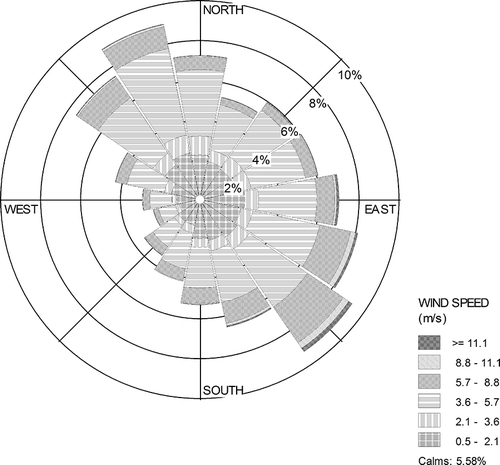
Figure 2. Wind speed class frequencies of the source location from the 10 years (1993 to 2002) of warm season (May to October) hourly meteorological data.
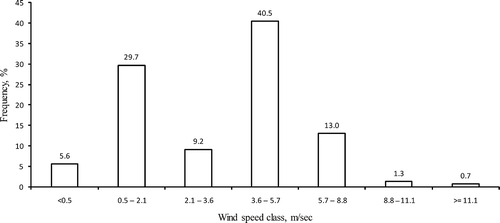
Stability class frequencies are shown in Almost half of the hours (46.4%) in the warm season of the source location were under neutral conditions (stability class = D). Frequencies of stable conditions (stability classes E and F) were the same at 15.3%. Unstable conditions (stability classes A, B, and C) had a total frequency of 23.1%, in which 15.6% of the hours were under stability class C.
LODM Predicted Odor Frequencies by Two Methods
LODM predicted hourly mean odor concentrations using the Hogström dispersion parameters with a defined stability index different from the Pasquill-Gifford (P-G) dispersion parameters and the P-G stability class. It was shown in a previous study11 that the LODM predicted hourly mean odor concentrations were larger than those predicted by the ISCST3 and CALPUFF models using P-G dispersion parameters. LODM predicts the hourly frequency with an improved method named weighted odor exceeding half width, which is based on the Gaussian fluctuating plume model. It takes the short time odor fluctuations into account. For example, for an hour with the mean odor concentration of 2 OU, when calculating the odor frequency of odor exceeding 1 OU using the hourly mean odor concentration, the frequency of this hour is 1; however, when calculated using the hourly frequency method, the odor frequency for this hour will be less than 1. In contrast, if an hour has a mean odor concentration of 0.5 OU, the odor frequency of this hour is 0 with the hourly mean odor concentration method, whereas it will be larger than 0 with the hourly frequency method. shows a comparison of the seasonal odor frequencies of 1 OU calculating by the two methods for the simulating warm season at the 441 receptors. It can be seen that the odor frequency of 1 OU with the hourly mean concentration method is larger than those with the hourly odor frequency method.
Directional Setback Distances
Directional Setback Distances Determined from the Seasonal Hourly Mean Odor Concentration
shows the seasonal hourly mean odor concentration around the selected farm. The isopleths of the seasonal hourly mean odor concentrations of 1, 3, 5, and 10 OU are shown in the figure. Generally, the seasonal hourly mean odor concentrations leeward (the direction downwind from the odor source) of the frequent winds were higher at the same distance than other directions. shows the directional setback distances determined from seasonal hourly mean odor concentrations with 1, 3, 5, and 10 OU. If 1 OU was selected as the acceptable odor criterion, the setback distances were from 3.9 to 12.1 km, which were greater than the Saskatchewan, Canada, guideline (3.2 km) and almost all the other available setback guidelines in the world. When 3 OU was selected, the setback distances were from 2.1 to 4.2 km, which were close to the Saskatchewan guideline values. When 5 or 10 OU were selected, the setback distances were from 2.0 to 3.0 km and 1.6 to 2.3 km. The different odor criteria selected result in different setback distances, which should be expected. The challenge remains selection of the appropriate odor criteria. The seasonal hourly mean odor concentration fails to fully reflect odor impact on human perceptions. The odor annoyance to human perception depends on the frequency, intensity, duration, and offensiveness (FIDO) of the odor.Citation13 The seasonal hourly mean odor concentration only indirectly reflects the intensity characteristic of odor. Therefore, the seasonal hourly mean odor concentrations are not recommended for determining setback distances.
Table 2. Directional setback distances determined from seasonal mean odor concentrations
Directional Setback Distances Determined from Odor Frequency with the Hourly Mean Odor Concentration Method
From the hourly mean odor concentrations predicted by the model, the hours that the odor concentrations exceed a certain level can be determined. The odor frequency can be then calculated by counting the number of hours with odor concentration exceeding a threshold. show the isopleths of odor frequencies of different odor levels (1, 3, and 5 OU). Although the locations of the odor frequency isopleths were different among the three levels, a similar pattern can be observed. The odor frequencies were higher leeward of the frequent winds than with less frequent winds. When the odor threshold was set at 1 and 3 OU, and the occurrence frequency was set equal to or lower than 0.05, the setback distances at many directions were beyond 10 km. When the odor threshold was set at 5 OU and the odor frequency was lower than 0.03, the setback distances at many directions were beyond 10 km.
Figure 6. Seasonal odor frequencies of 1 OU around the selected farm with the hourly mean odor concentration method.
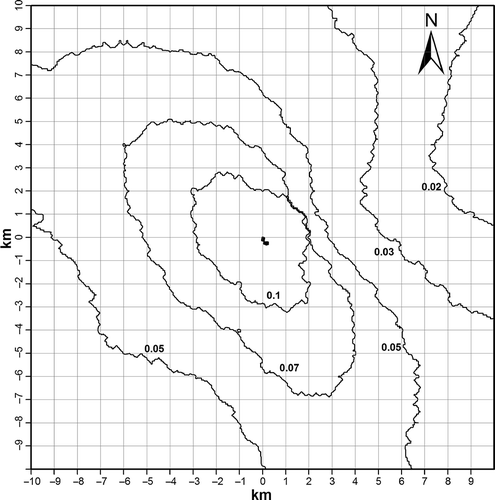
Figure 7. Seasonal odor frequencies of 3 OU around the selected farm with the hourly mean odor concentration method.
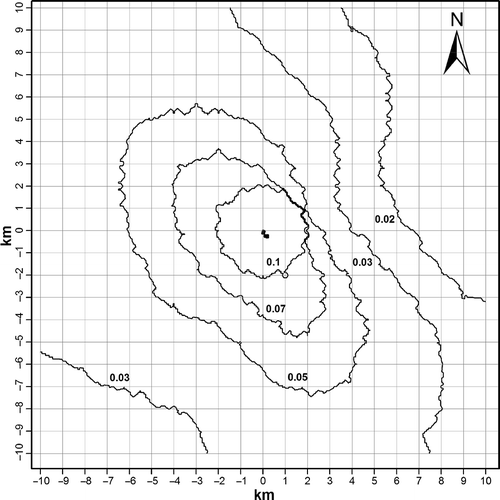
Figure 8. Seasonal odor frequencies of 5 OU around the selected farm with hourly mean odor concentration method.
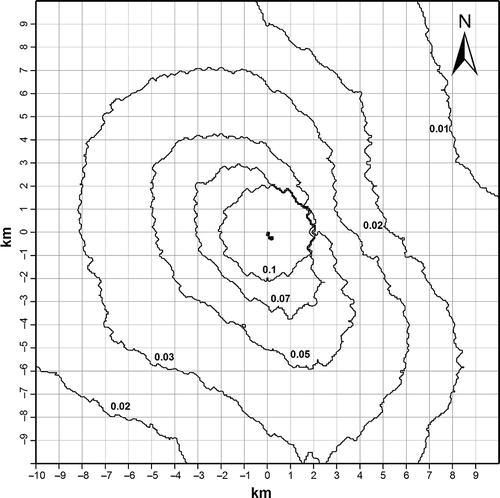
lists the setback distances in 16 directions when using different odor frequencies of different odor concentrations (1, 3, and 5 OU) with the hourly mean odor concentration method. When using 1 OU at 7% as the odor criterion, the setback distances were the largest at south-southeast (SSE) direction (7.3 km) and the smallest at north-northeast (NNE) direction (2.5 km). If the odor threshold increased to 3 and 5 OU, at the same occurrence frequency of 7%, the minimum setback distances decreased to 1.9 and 1.89 km, respectively, and the maximum setback distances decreased to 4.7 and 3.5 km, respectively. Using the same odor threshold, increasing occurrence frequency resulted in a dramatic decreasing of setback distance. For instance, when the odor criterion changed from 1 OU at 10% to 1 OU at 5%, the setback distance at the North increased from 2.3 to 6.3 km.
Table 3. Directional setback distances with different seasonal odor frequencies of 1, 3, and 5 OU with the hourly mean odor concentration method
shows the isopleths of the odor occurrence frequencies of 10 OU with the hourly mean odor concentration method. It had the same pattern as the odor frequencies of 1, 3, and 5 OU. More isopleths including the ones of 0.01, 0.02, and 0.03 can be seen within the 10 × 10 km study area. As seen in , increasing the odor tolerance level to 10 OU decreased the setback distances at all directions. When the odor criterion of 10 OU at 5% was used, the minimum and maximum setback distances were 2.0 and 4.0 km, respectively.
Figure 9. Seasonal odor frequencies of 10 OU around the selected farm with the hourly mean odor concentration method.
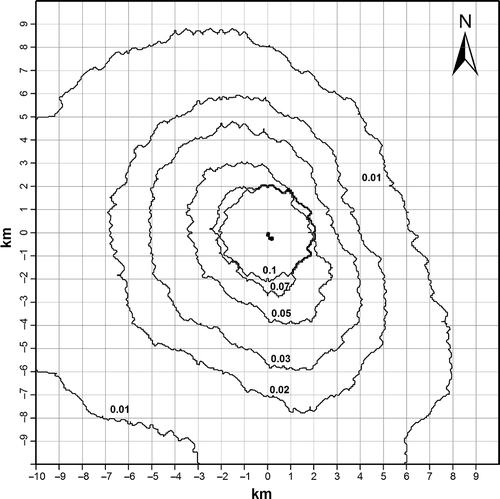
Table 4. Directional setback distances with different odor frequencies of 10 OU with the hourly mean odor concentration method
Directional Setback Distances Determined from Odor Frequency with Hourly Odor Frequency Method
show the isopleths of different odor occurrence frequencies of different levels of odor concentration (1, 3, 5, and 10 OU) using the hourly odor frequency method. The pattern was the same as with the seasonal mean hourly odor concentration and the odor frequencies calculated from hourly mean odor concentrations. The odor frequencies were higher leeward of the more frequent winds than the less frequent winds. Setback distances decreased with increasing tolerate levels of odor concentrations.
Figure 10. Seasonal odor frequencies of 1 OU around the selected farm with the hourly odor frequencies method.
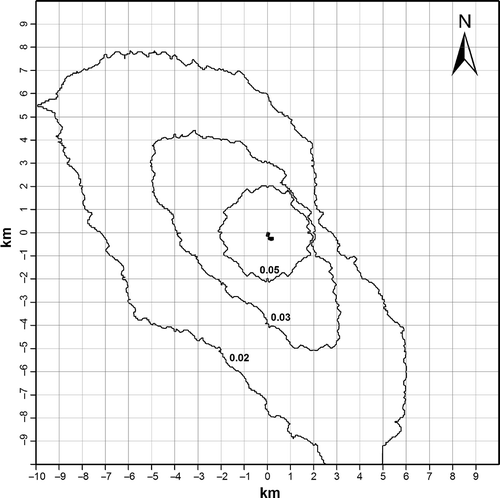
Figure 11. Seasonal odor frequencies of 3 OU around the selected farm with the hourly odor frequencies method.

Figure 12. Seasonal odor frequencies of 5 OU around the selected farm with the hourly odor frequencies method.
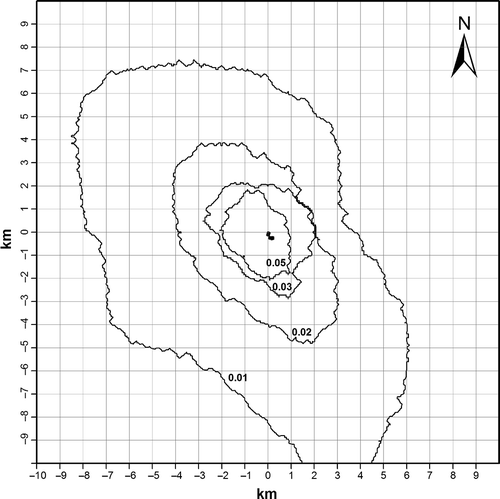
Figure 13. Seasonal odor frequencies of 10 OU around the selected farm with the hourly odor frequencies method.
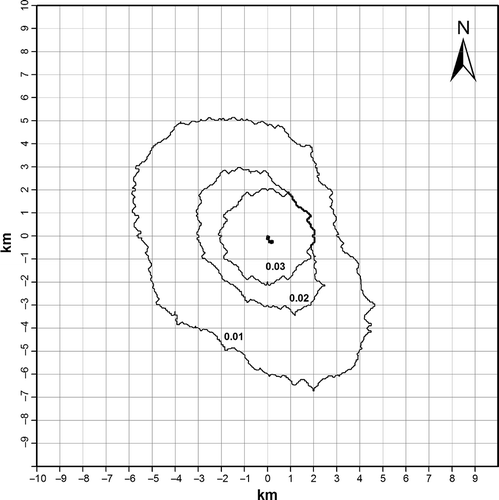
lists the setback distances at all 16 directions using different odor criteria. If the odor criterion was set as 1 OU at 3%, the minimum and maximum setback distances were 1.9 and 6.0 km, respectively. If the odor frequency increased to 5%, the maximum setback distances decreased dramatically to 2.2 km. If the odor criterion was set as 3 OU at 3%, the setback distances were in the range of 1.9 to 3.5 km. Using 5 and 10 OU as the odor threshold would further reduce the setback distance at the same odor frequency. Comparing to the setback distances using the odor criteria with odor frequencies from the hourly mean odor concentration method, the setback distances were much lower with the hourly frequency method. However, the smaller setback distances raise the risk of the complaints from the surrounding communities. The hourly frequency method considers the short time odor fluctuations, thus it better reflects the actual odor impact on the receptors. The setback distances estimated by this method when using 1 OU at 3% as odor criterion were between 1.9 and 6.0 km, which are similar to the values recommended by the Saskatchewan guideline.
Table 5. Directional setback distances with different seasonal odor frequencies of 1, 3, 5, and 10 OU with the hourly frequency method
CONCLUSION AND RECOMMENDATIONS
The directional setback distances were calculated for a typical swine farm in Saskatchewan, Canada. Ten years of warm season (May to October) meteorological data were used to predict hourly mean odor concentrations and hourly odor frequencies. The seasonal mean odor concentrations and the seasonal occurrence frequencies of different levels of odor were calculated. Two approaches were used to achieve the seasonal odor occurrence frequencies. One was directly from hourly mean odor concentration and the other from hourly odor frequencies. Directional setback distances were obtained using the results of seasonal mean odor concentrations and the seasonal odor frequencies obtained using the spatial analysis tools in GIS. It was concluded that the hourly mean odor concentration method produced higher seasonal odor frequencies than the hourly odor frequency method. The seasonal mean odor concentration and the odor frequencies calculated by the two methods had the same pattern: the area leeward of the frequent winds had higher odor concentrations and higher odor frequencies than other directions. The hourly frequency method suggested smaller setback distances than the hourly mean odor concentration method. When the odor criterion of 1 OU at 3% was used, the setback distances produced by the hourly frequency method were similar to what recommended by the Saskatchewan guideline.
This study proved that LODM can be used to determine the setback distances with its predicted hourly mean odor concentrations and hourly odor frequencies. Selection of appropriate odor criteria is still the challenge of the setback distance determination. Historical complaint data and community survey data might serve as an effective tool for selecting odor criteria. Future research should focus on the selection of appropriate odor criteria and development of a setback distance model based on the new livestock odor dispersion model (LODM).
ACKNOWLEDGEMENTS
This research has been funded by the CIHR Strategic Training Program in Public Health and the Agricultural Rural Ecosystem (PHARE), the Canadian Centre for Health and Safety in Agriculture, and CIHR Partner Institutes including the Institute of Health Services and Policy Research, Institute of Circulatory and Respiratory Health, Institute of Infection and Immunity, and the Institute of Population and Public Health.
REFERENCES
- Yu , Z. , Guo , H. and Laguë , C. 2009 . Setting Acceptable Odor Criteria Using Steady-State and Annual Hourly Weather Data . Biosystems Eng. , 103 : 329 – 337 .
- Guo , H. , Jacobson , L.D. , Schmidt , D.R. , Nicolai , R.E. and Janni , K.A. 2004 . Comparison of Five Models for Setback Distance Determination from Livestock Sites; Can . Biosyst. Eng. , 46 : 17 – 25 .
- Piringer , M. and Schauberger , G. 1999 . Comparison of a Gaussian Dispersion Model with Guidelines for Calculating the Separation Distance between Livestock Farming and Residential Areas to Avoid Odor Annoyance; Atmos . Environ. , 33 : 2219 – 2228 .
- Scharberger , G. , Piringer , M. and Petz , E. 2001 . Separation Distance to Avoid Odor Nuisance Due to Livestock Calculated by the Austrian Odor Dispersion Model (AODM); Agric . Ecosyst. Environ. , 87 : 13 – 28 .
- Jacobson , L.D. , Guo , H. , Schmidt , D.R. , Nicolar , R.E. , Zhu , J. and Janni , K.A. 2005 . Development of OFFSET Model for Determination of Odor Annoyance Free Setback Distance from Animal Production Sites, Part I: Review and Experiment; Trans . ASABE , 48 : 2259 – 2268 .
- Guo , H. , Jacobson , L.D. , Schmidt , D.R. , Nicolar , R.E. , Zhu , J. and Janni , K.A. 2005 . Development of the OFFSET Model for Determination of Odor-Annoyance-Free Setback Distances from Animal Production Sites: Part II . Model Development and Evaluations; Trans. ASABE , 48 : 2269 – 2276 .
- Stowell , R.R. , Koppolu , L. , Schulte , D.D. and Koelsch , R K. Applications of Using the Odor Footprint Tool . Proceedings: Livestock Environment VII, Proceedings of the Seventh International Symposium . May 18-20 2005 , Beijing , China . pp. 496 – 503 . St. Joseph , MI : ASAE . Paper 701P0205
- Yu , Z. , Guo , H. and Laguë , C. 2010 . Livestock Odor Dispersion Modeling: A Review; Trans . ASABE , 53 : 1261 – 1244 .
- Scharberger , G. , Piringer , M. and Petz , E. 2002 . Calculating Direction-Dependent Separation Distance by a Dispersion Model to Avoid Livestock Odor Annoyance . Biosyst. Eng , 82 : 25 – 37 .
- Yu , Z. , Guo , H. and Laguë , C. 2011 . Development of a Livestock Odor Dispersion Model (LODM): Part I. Model Theory and Development . J. Air Waste Manage. Assoc. , 61 : 269 – 276 . doi: 10.3155/1047-3289.61.3.269
- Yu , Z. , Guo , H. and Laguë , C. 2011 . Development of a Livestock Odor Dispersion Model (LODM): Part II. Evaluation and Validation; J. Air Waste Manage . Assoc. , 61 : 277 – 284 . doi: 10.3155/1047-3289.61.3.277
- Guo , H. , Dehod , W. , Agnew , J. , Laguë , C. , Feddes , J. and Pang , S. 2006 . Annual Odor Emission Rate from Different Types of Swine Production Buildings; Trans . ASABE , 49 : 517 – 525 .
- Watts , P.J. , Sweeten , J.M. , Watts , P.J. and Sweeten , J.M. June 1995 . “ Toward a Better Regulatory Model for Odor ” . In Proceedings of Feedlot Waste Management Conference , June , 12 – 14 . Queensland , , Australia : Torrey Pines Resort, Gold Coast .
